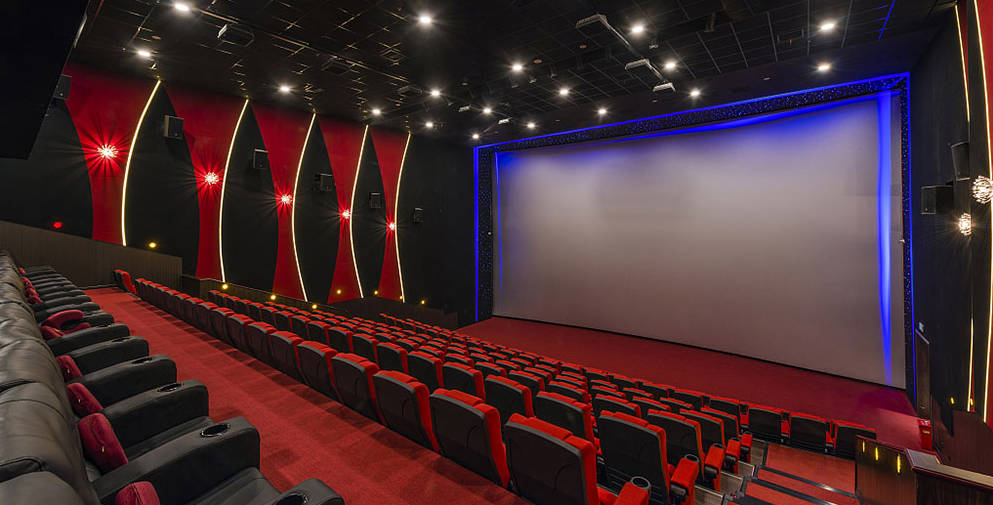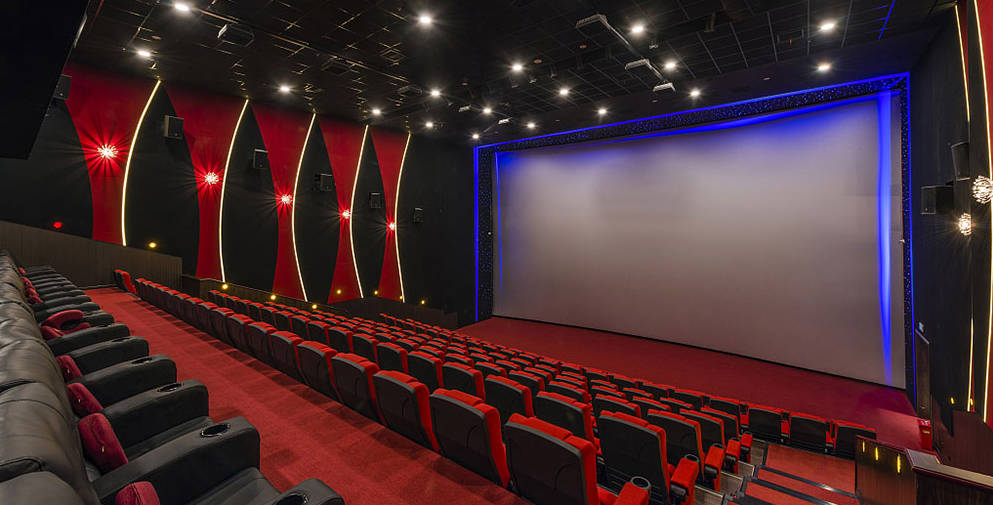notice:
Search:
Code for acoustic design of cinema buildings

admin
Acoustic PET Felt Panels Factory | Akupanel & Acoustic Wall Panels Manufacturer - Guangdong Yuefa Acoustic New Materials Co., Ltd

1、 Overview of Acoustic Design in Cinema Buildings
A cinema is a place where movies are screened for the audience. It is composed of the audience hall, public areas, projection room, and other rooms (including VIP reception room, building equipment room, intelligent system room, etc.). Eliminating the focus of audience hall sound, trembling echoes, and multiple echoes, reducing the sound interference of noise on the sound reinforcement system, and creating a good audio-visual effect, the architectural acoustic design of cinemas is an essential part. The acoustic design of cinemas mainly includes aspects and requirements such as reverberation control, sound insulation design, and noise control.
Cinemas can be divided into three categories based on sound channels: regular channel, stereo channel, four channel, and six channel.
The scale of cinemas can be divided into super large, large, medium, and small according to capacity.
Classification of cinemas by seating capacity
| 总座位数 | 观众厅数 | |
| 特大型电影院 | 1801以上 | 11以上 |
| 大型电影院 | 1201~1800 | 8~10 |
| 中型电影院 | 701~1200 | 5-7 |
| 小型电影院 | 700以下 | 4以下 |
According to JBJ 58-2008 "Code for Design of Cinema Buildings", the quality standards of cinemas are divided into four levels: special, A, B, and C.
2、 Relevant standards and regulations for acoustic design of cinema buildings
1. "Code for acoustic design of theaters, cinemas, and multi-purpose halls" (GB/T 50356-2005)
2. Code for Design of Cinema Buildings JBJ58-2008
3. Technical Requirements for Audiovisual Environment of Cinemas GB/T 3557-94
4. Environmental Quality Standards for Noise (GB 3096-2008)
5. Design Specification for Hall Sound Reinforcement System (GB 50371-2006)
6. GBJ76-84 "Measurement Specification for Hall Reverberation Time";
7. "Building Sound Insulation and Absorption Structures" (National Building Standard Design Atlas 08J931)
8. Code for Indoor Environmental Pollution Control in Civil Building Engineering (GB50325-2001)
9. Code for Fire Protection Design of Buildings GBJ16-1987 (2001 Edition)
10. "Code for Fire Protection Design of Interior Decoration of Buildings" (GB50222-95)
11. Code for Design of Sound Insulation in Civil Buildings (GB 50118-2010)
12. Technical Specification for Digital Stereo Cinema GY/T 183-2002
13. Star rating requirements for cinemas - Document of the State Administration of Radio, Film and Television
14. Green Building Evaluation Standards GB/T 50378-2006
3、 Reverberation time in acoustic design of cinema buildings
《Technical Requirements for Audiovisual Environment in Cinemas》GB/T 3557-94
| 单声道观众厅 | 立体声观众厅 | |||
| 容积(平方米) | 500~200 | 2000以上 | 500~2000 | 2000以上 |
| 500Hz混响时间(s) | 0.5~0.8 | 0.8~1.2 | 0.4~0.6 | 0.6~1.0 |
The ratio of reverberation time at each frequency to 500Hz
| 频率(Hz) | 混响时间比值 |
| 125 | 1.0~1.4 |
| 250 | 1.0~1.5 |
| 1000、2000 | 1.0 |
| 4000 | 0.8~1.0 |
《Code for acoustic design of theater, cinema, and multi-purpose hall buildings》(GB-T50356-2005)
500-1000Hz reverberation time in cinema auditorium
| 容积(m3) | 中频泥响时间(S) | |
| 普通 | 立体声 | |
| <1000 | 0.6~0.8 | 0.48~0.65 |
| 1000~6000 | 0.7~1.1 | 0.52~0.85 |
| 6000~10000 | 0.85~1.15 | 0.63~0.9 |
The ratio of reverberation time at different frequencies in the cinema audience hall to 500-1000Hz
| 频率(Hz) | 混响时间比值 |
| 125 | 1.0~1.2 |
| 250 | 1.0~1.1 |
| 2000 | 0.9~1.0 |
| 4000 | 0.8~1.0 |
《Technical specifications for digital stereo cinemas》GY/T 183-2002
各频率混响时间相对500Hz的比值
| 频率(Hz) | 混响时间比值 |
| 63 | 1.0~1.5 |
| 125 | 1.2 |
| 250 | 1.0~1.1 |
| 1000 | 1.0 |
| 2000 | 0.8~1.0 |
| 4000 | 0.7~1.0 |
| 8000 | 0.6~0.9 |
(1) Solution
1. The architectural design of cinemas should include acoustic design, which should run through the entire process of cinema design.
2. The back wall of the audience hall should adopt a full frequency band strong sound-absorbing structure to prevent echo. The average coefficient should not be less than 0.6s in the range of 125-4000 Hz, and the sound absorption coefficient at 125 Hz should not be less than 0.4.
3. The wall behind the silver screen should be treated with sound absorption
4. Reasonably arrange sound-absorbing materials according to the shape of other walls
5. The ceiling should be arranged reasonably based on the area and type of sound-absorbing materials according to the level of the cinema.
6. Reasonable selection of seats (fully considering the material of the seats and the noise pollution generated)
7. A seat with good stereo effect covers more than two-thirds of all seats.
(2) Solution
1. When the roof engineering of the audience hall adopts a lightweight roof, sound insulation and vibration reduction measures should be taken
2. The setting of elevators or escalators in cinemas should not be close to the audience hall. When setting up close proximity, measures such as sound insulation and vibration reduction should be taken
3. Various types of buildings should be arranged in zones according to their noise levels. Noisy rooms should not be placed adjacent to the audience hall. When setting up in close proximity, measures such as noise reduction, sound insulation, and vibration reduction should be taken. For example, boiler rooms or cooling towers should not be set up in close proximity to the audience hall; When setting up close proximity, measures such as noise reduction, sound insulation, and vibration reduction should be taken.
4. The audience hall should use public spaces such as rest halls, foyers, and corridors as sound insulation and noise reduction measures, and sound barriers should be installed at the entrance and exit of the audience hall.
5. Choose low-noise air conditioning and ventilation systems. Take corresponding measures to prevent interconnection between halls. Air conditioning or ventilation systems should be equipped with noise reduction and vibration isolation measures. The noise transmitted through the air vent to the audience hall is 5dB lower than the allowable noise inside the hall
6. The wall of the audience hall cannot be perforated, and all pipes that need to pass through the wall must be sealed properly. The power sockets on both sides of the wall should be installed in a staggered manner to achieve the best sound insulation measures.
7. The partition wall between the audience hall and the projection room should be treated with sound insulation, and the intermediate frequency (500-1000Hz) sound insulation should not be less than 45dB.
8. The sound insulation between adjacent auditoriums should not be less than 50dB for low frequencies and 60dB for medium to high frequencies.
9. The sound insulation of the soundproof door in the audience hall should not be less than 35dB. Spaces with sound barriers should undergo sound absorption and noise reduction treatment.
10. All air conditioning rooms, ventilation rooms, refrigeration rooms, water pump rooms, transformer and distribution rooms, lighting control rooms, etc. must be treated with sound absorption and noise reduction, sound insulation and vibration reduction. Its sound insulation and vibration reduction capabilities should ensure that the noise transmitted to the audience hall is 5dB lower than the allowable noise inside the hall
5、 Material preparation for acoustic design of cinema buildings
1. The selection of materials for interior decoration in the audience hall should prevent interference with light and use non reflective decorative materials
2. The screen frame, back wall of the screen, nearby side walls, and ceiling in front of the screen should be decorated with matte black or dark materials. The entrance, main screen, and edge screen should be decorated with matte black or dark materials
3. The floor of the projection room should be made of anti-static, dust-proof, wear-resistant, and easy to clean materials
4. The seating step structure in the audience hall should be made of non combustible materials
5. The ceiling materials in the audience hall, sound barriers, and evacuation routes should be A-grade decoration materials, and the wall and floor materials should not be lower than B1 grade
6. Audience hall ceiling should use A-grade materials for sound absorption, insulation, insulation, and maintenance tracks
7. The projection room should be separated from other parts by partition walls with a fire resistance limit of no less than 2.0 hours and floor slabs with a fire resistance limit of no less than 1.5 hours. The ceiling decoration materials should not be lower than grade A, and the wall and floor materials should not be lower than grade Bl.
8. The keel materials used for the ceiling and wall decoration of the cinema should be A-grade materials
9. The indoor decoration ceiling of smoking rooms in cinemas should be made of A-grade materials, and the floor and walls should be made of materials not less than B1 grade
10. The number of evacuation doors in the audience hall should be determined through calculation and should not be less than 2. And it should not be less than 0.90m. Grade A fire doors should be used.

Hot products
-
Wooden Grooved Wall Panels
China's Leading Wooden Grooved Wall Panels Manufacturer - Get premium quality acoustic wood slat panels at factory-direct prices. Our FSC-certified grooved wall panels feature custom CNC designs (5-20mm depth), excellent sound absorption (NRC 0.6-0.9), and 12+ finish options. Ideal for commercial spaces, residential interiors, and acoustic treatment. ISO 9001 certified with 15+ years experience. MOQ 100㎡ with free samples available. OEM/ODM services supported. Contact us today for wholesale pricing from China's trusted wood wall panel supplier!
-
Wholesale Anti-Vibration Pads
Source high-quality wholesale anti-vibration pads for machinery, construction, and OEM projects. Get competitive bulk pricing, global shipping, and custom solutions from trusted suppliers.
-
Private Soundproof Pod Booth For Office
Flexible and movable soundproof booth.the interior is equipped with polyester fiber sound-absorbing panels. It has the advantages of fire prevention, safety and stability.
-
Micro Perforated Wood Acoustic Panel
The materials of Micro Perforated Wood Acoustic Panels are made of MDF with microperforations on the visible side and big holes in the back side.
-
Smoked oak sound-absorbing board, black felt
As a leading Chinese acoustic panel manufacturer, our factory specializes in producing Akupanel wooden slat acoustic panels that combine aesthetic appeal with superior noise reduction performance. These wood wall acoustic panels are ISO 9001 certified, featuring Class A fire ratings and NRC 0.85 sound absorption coefficients.
-
Standard 9 mm PET Felt panels
Discover customizable acoustic wall panels made from 100% recycled PET polyester fiber. Achieve NRC 0.85+ sound absorption with eco-safe (12 bottles recycled/panel), fire-resistant (Class A/B1) solutions. Perfect for studios, offices & modern interiors. Custom sizes/colors available. LEED & GREENGUARD Gold certified.
-
Sound Insulation Wood Wool Acoustic Panel
Wood fiber acoustic board is a decoration and sound insulation material, using pure wood wool as raw material which is characterized by available for a variety of colors and patterns to choose from, the finishes color can be adjusted according to the requirements of the acoustic renovation or investors; wool wood acoustic panel sound absorption spectrum is high, which have fairly good results for low, medium and high frequency noises, and good fire-proof, no dust pollution, strong decorative and simple to use. There are many specification levels available for investors to choose, you can simply note when ordering.
-
Perforated Wood Acoustic Panel
Product introduction: Acoustic Wood panels is a sound-absorbing material of MDF material with many holes. It is widely used in theater, restaurant, household and other places which need to reduce noise. DIY Perforated Acoustic Panel Precautions: l Wood or melamine veneer with different colors is natural phenomenon. l Pay attention to moisture before installation. Please keep them in a dry environment.
-
Polyester Acoustic Panel (standard)
High-performance polyester fiber acoustic panels for noise control and sound absorption. Eco-friendly soundproofing solution for commercial and residential spaces with Class A fire rating.
-
Premium Decorative Natural Grooved Akupanel Wooden Acoustic Panels – Direct from China Manufacturer
As a leading China-based acoustic panel factory, we specialize in crafting high-quality Decorative Natural Grooved Akupanel Wooden Acoustic Wall Panels that combine aesthetic appeal with superior sound absorption. Our products are engineered for architects, interior designers, and contractors seeking eco-friendly acoustic solutions with customizable designs.
-
Modern Office Meeting Pods - 2 Steel Walls + 2 Glass Walls - Custom Sizes Available
China factory-direct manufacturer of premium soundproof meeting pods featuring 2 metal walls + 2 glass walls. Our ISO-certified office pods deliver 38dB noise reduction with quick-ship modular designs. Custom sizes/colors available with 5-year warranty. Ideal for offices, coworking spaces & universities. Competitive pricing with bulk order discounts. Request CAD files & quotes today!
-
20mm polyster fiber panel directly supplied by Chinese manufacturers
PET Acoustic Panel is made from 100% polyester,by needle punching processing. The production processis completely physical&eco-friendly, no waste water,emissions, waste. no adhesive, The porous nature ofacoustic panel makes it sound absorptive&thermalinsulative.
-
Wall And Ceiling Acoustic Perforated Wood Panels
Premium grade perforated wood acoustic panels for wall and ceiling applications. Achieve 0.90 NRC with Class A fire-rated natural wood panels. Custom patterns & finishes for architectural acoustics.
-
Waterproof PVC Sound Barriers
Our sound insulation products help protect and reduce the impact of industrial noise on surrounding residents and on-site workers.We use the world's leading acoustic technology and innovative material design to provide the most effective temporary sound solutions on the market.The one of most important thing is that soundproof products can work under various conditions on any construction site.
-
300x300mm Hexagon Wall Panels - Soundproof Polyester Fiber Acoustic Panels for Easy Installation
Upgrade your space with our 300x300mm hexagon acoustic panels. Made from high-density polyester fiber, these soundproof wall panels effectively reduce noise and echo. Quick installation, stylish design, and premium sound absorption for offices, studios, and homes.
-
24mm PET Acoustic Panels Polyester Fiber Sound Absorbing Material
Our 24mm PET Acoustic Panel answers your acoustical and aesthetic needs with its strong sound-absorbing performance, durability, and elegant appearance. These panels are used for sound reduction and reverberation control. Available in a wide variety of sizes, thicknesses, fabric styles, and colors. 24mm PET Acoustic Panels allow you to create an effective sound control treatment that is distinctly appropriate for your environment.
Cases
-
Acoustic Decoration Project of Guangzhou Metro Museum
Acoustic Decoration Project of Guangzhou Metro Museum
-
Acoustic Decoration Project for Lecture Hall - Nanhai Middle School Renovation and Expansion Project
The original acoustic design of the auditorium at Nanhai Middle School can no longer meet the needs of modern teaching and activities, especially in large-scale lectures, conferences, and cultural events. The uniformity of the sound field and the clarity of speech directly affect the efficiency of information transmission and learning outcomes. Therefore, carrying out scientific and reasonable acoustic decoration is the top priority of current work.
-
Nanhai Middle School Lecture Hall
The original acoustic design of the auditorium at Nanhai Middle School can no longer meet the needs of modern teaching and activities, especially in large-scale lectures, conferences, and cultural events. The uniformity of the sound field and the clarity of speech directly affect the efficiency of information transmission and learning outcomes. Therefore, carrying out scientific and reasonable acoustic decoration is the top priority of current work.
-
Acoustic Renovation Case of Lecture Hall (Dongguan Songshan Lake School Junior High School Project) - Yuefa Acoustics
The lecture hall is not only used for hosting large-scale conferences, cultural performances, and social events, but also often serves multiple functions such as education and training, exhibitions, etc. The goal of acoustic renovation is to optimize the sound field distribution, reduce noise interference, and improve audio clarity, so that the auditorium can better adapt to various needs.
-
Acoustic architectural decoration of the multifunctional hall at Xinyu Ninth Middle School
Yuefa Acoustics provides professional multifunctional hall acoustic decoration design solutions, including architectural acoustics, sound reinforcement, and noise control design, with the aim of ensuring language clarity in the audience seats.
-
Songshan Lake Taiwan Garden North School - Classroom Acoustic Decoration Project
In the current educational environment, the acoustic design and decoration of classrooms are receiving increasing attention. A good acoustic environment can not only improve students' learning efficiency, but also provide teachers with a better teaching space. As a modern educational institution, Songshan Lake Taiwan Garden North School has realized this and therefore carried out classroom acoustic decoration projects in order to create an ideal learning and teaching environment for teachers and students.
-
Shenzhen Longhua Experimental School Concert Hall
Shenzhen Longhua Experimental School Concert Hall
Online Service



